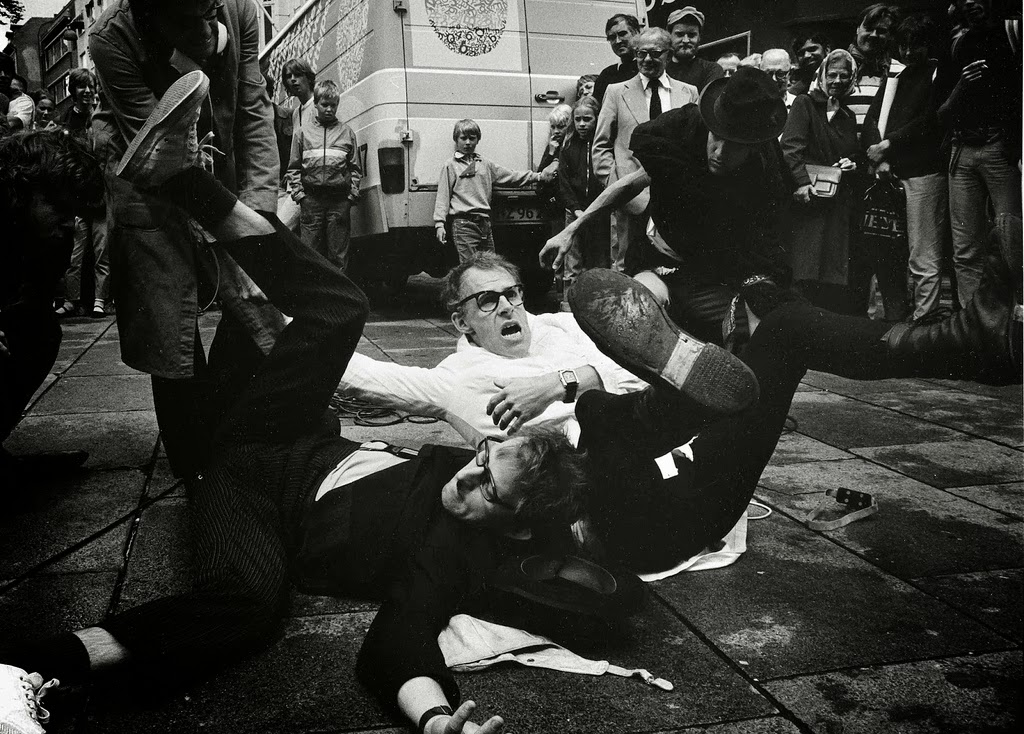"Tüm o yaptıklarını yapıp bitirdikten sonra, kalkıyorlar, yıkanıyorlar, pudralanıyorlar, koku sürüyorlar, saçlarını tarıyorlar, giyiniyorlar ve böylece yavaş yavaş yeniden olmadıkları gibi olmaya başlıyorlar." Julio Cortazar
"ÖYKÜ
OKUNABİLİR GERİLİMDİR"
Julio
Cortazar 1967 yılında Paris'te ünlü fotoğraf sanatçısı Sara Facio'nun
objektifinin karşısına geçtiğinde elli bir yaşındaydı. Birkaç günlük çalışmadan
sonra dünya 20. yüzyıl yazarlar albümünün en etkileyici fotoğraflarından biri
ortaya çıkmıştı. Bu fotoğrafta Cortazar'ı ağzında yakılmamış bir sigara ile
görürüz. O pozdaki eda sinemaya geçmiş İngiliz Kraliyet Tiyatrosu
oyuncularındaki karizmayı aratmaz. Temposu ağır, kahramanlar arasındaki
psikolojik didişmeyi zor sahneler ve humor yüklü diyaloglarla işleyen bir
filmin karakteristik jönü vardır orada. Öykücü ve romancı Cortazar, sanki hem
kendi yazarlık yaşamındaki ikilemi hem de bir sinema oyuncusunun rol gereği
ikilemini çok iyi yansıtır, oynar bu fotoğrafta. Yazar olarak, hem
Nietzsche'nin "görülebilir ve dokunabilir süreçler halinde yazmak"
önerisinde olduğu gibi, süreçlerin mantıksal pasajlarla ilerlediği roman hem
poetik çağlayışlarla akan öykü metinleri arasında durmuş gibidir. Sabırlı,
vakur olduğu kadar, birazdan kayıplara karışıp ayrıksı, romantik ve şakacı
tavrıyla yeni bir öyküye başlayacak gibidir.
Sara Facio
ondaki caz ve sinema tutkusunu anlatır kısa metinlerle süslediği fotoğraf
albümünde. Caz: Öykü, sinema: Roman; Cortazar'ın tutkularında bile vardır bu
ikilem.
"Dilemma",
yani 'ikilem'; "Juego", yani 'oyun'; edebiyatın kuralcı ve belirgin
söylemi (discurcion) dışına çıkmak isteyen, insana verilmiş mekanik dil
yetisini yaratışın alanlarını keşif yolunda kullanmak isteyen yazarların
tarzlarını etkileyen iki öğedir.
İkilem,
başta, özgün yazarın dil kategorisini 'içsel konuşma' versiyonları ile
aşkınlığa götürmesidir. Dünya görüşü fenomeni bakımından da özgün yazar
kavranamaz. Yazdıklarıyla yaşamı arasında bu bakımlardan hep bir ikilem vardır.
Julio Cortazar örneğinde bu iki çatışmayı görüyoruz.
Fantastik
İmgeci Cortazar ve Politik Bağlanıştaki Cortazar
Julio
CortazarBazı okurlar vardır ki onlar, okumayı 'eylem' olarak kabul ederler. Bu
'eylem', hümanizmin insani uyumlaştırıcı özüne hizmet eden kültürel beslenme
adına yapılabildiği gibi, düpedüz bir politik-kültürel faaliyet adına da
yapılabilir. Yine, metinsel algılayış ve haz 'eylemcileri' olduğu gibi, branş
literatürü estetiğinin peşinde 'eylemciler' de vardır. Tüm bu grupların ortak
özelliği "kusursuz okur" tipini önlerine koymalarıdır. Şaşmaz, güvenli,
yerine göre hijyenik… daha bir sürü sıfat kullanılabilir. 'Kusursuz okur'
fantastik imgeci Cortazar ile politik bağlanıştaki Cortazar'ı kesin olarak
birbirinden ayırmayı başarmıştır. Onlara göre Cortazar için (Cortazar yeteneği
için) ancak böyle bir bölümleyiş güvenlidir. Tabii bu ayırmayı yaparken, onun
bir yanının öbüründen sürekli olarak diyalog talep ettiğini göz ardı ettiler.
Onun fantastik imgeciliğine vurgun olan 'kusursuzlar' öykülerini (öykücü
Cortazar'ı), politik bağlanışını önemseyen 'kusursuzlar' ise romanlarını
(romancı Cortazar'ı) öne çıkardılar. Sonunda Cortazar'ın kendisi de okurlarının
iki ayrı yarıkürede ikamet ettiklerini kabul etmek zorunda kaldı. (Bunu yakın
dostu eleştirmen Julio Ortega'dan öğreniyoruz: Julio Ortega, "Toda la vida
en juego", 14 Şubat 2004, El Pais.) Yazar bir keresinde Julio Ortega'ya şu
yorumda bulunur: "Bu ayrım retorikten geliyor olsa gerek, keşke öykünün
gölgesiyle boğuşmadan romana geçmek kabil olsaydı" (agy). Cortazar
uyuşmazlığın eserlerinden kaynaklandığını sezmişti, fakat bu ikilem için bir
yanıtı yoktu; öykü, bir can sıkıntısının şaşmaz haritası; roman, bir yaşam
projesi (Julio Ortega'dan aktarıyoruz).
Denir ki
sanatçılar yanıtlarını eserleriyle verir. Bu söz hamaset koksa da doğrudur.
Eserlerinde, onların bir yerinde, bir bakarsınız, yanıt verilmiştir.
Rayuela'nın (Dilimize Necla Işık tarafından Seksek adıyla çevrilmiştir.)
kahramanı Oliveira dehşetli anarşist hezeyan anlarında sanatçı ahlakının
bireycilikte değil toplumculukta olduğunu keşfettiğinde, yanıt verilmiştir.
Gerçekte Rayuela'da olan nedir? Orada "Ben"in bütün arayışı
"Ötekiben" ile buluşmaya koşar. Cortazar'ın, edebi eserlerinin yanı
sıra, oldukça politik metinleri vardır. Yazar o metinlerde hep tasavvuru ve
karşıtlığı arar. O metinlerde politik bağlanış apaçık olmasına rağmen, yazar
hiçbir zaman şiirselliği elden bırakmaz; doğrular, ahlaki, politik önermeler ve
protestolar insani özgürleşmenin ışığı ile aydınlanır.
Cortazar
Okumanın Yol Haritası
20. yüzyılın
Arjantinli büyük yazarı Julio Cortazar'ın entelektüelliği üzerine yoğunlaşan
bir tartışmayı onun bir eserinde simgesel olarak noktaladık. Yazarlığı,
özellikle de öykü edebiyatındaki yazarlığı üzerinde durmamız gerekir. Ne de
olsa 20. yüzyılın ikinci yarısından sonraki dünya öykü edebiyatında onun
damgası vardır.
Julio
Cortazar üçüncü küreselleşmeye doğru giden dünyada (dünyanın bir küre olarak
tasarlanması -I-, finans kapitalin ortaya çıkışı -II-, pazariçi üretim
olanaklarının daralması -III-) son sanatçı yazarlardandır. Bu sıfatı zapt
edilemez biçimde bütün yaşam tarzlarına el atması ve bunları lirik ve trajik
olarak ortaya sermesi, ayrıca ironiyi dünyayı ve yaşamı tanımanın bir yöntemi olarak
benimsemesiyle hak eder.
20. yüzyılın
en büyük fenomenlerinden biri de 'Latin Amerika boom' diye adlandırılan,
1960'lar sonrası Latin Amerika ülkelerinde gelişen İspanyolca edebiyattır.
Şiirde, Pablo Neruda, Cesar Vallejo ve Octavio Paz; düzyazıda, Romulo Gallegos,
Juan Rulfo, Borges, Arturo Uslar Pietri, Miguel Angel de Asturias, Gabriel
Garcia Marquez, Julio Cortazar, Mario Vargas Llosa ve Carlos Fuentes bu
fenomeni vücuda getiren kalemlerin başlıcalarıdır.
Arjantinli
yazar ve edebiyat profesörü Saul Yurkievich tarafından yayıma hazırlanan Julio
Cortazar'ın Tüm Eserleri'nin giriş yazısında bir tanımlayış dikkati çeker: Bir
edebi anıt (Julio Cortazar, Obras Completas, Edicion de Saul Yurkievich,
Galaxia Gutenberg/Circulo de lectores, Barcelona, 2003).
'Bir edebi
anıt,' bu tanımlayış edebiyat tarihine uygun düşüyor. Ölümünün 20. yılında bir
yazarı edebiyat tarihine emanet etmek işin kolayı. Onun edebi etkinliği
bakımından tarihsicilik kaçınılmaz olarak bu şekilde devreye girer. Julio
Cortazar'ın eserlerine dönüp bakacak olursak, tarihsellik, şakacılığını ortaya
koyacaktır.
Julio
Cortazar'ın eserleri edebiyat tarihine uygun mudur?! Geçmişin düzeni içinde bir
uygunluktan söz ediyorsak, ki bunun için ulusalcı bir zemin, kuralcı ve
belirleyici söylemler gerekir, olumsuz bir durum görünüyor. Ayrıca akışı
güçlendiren okuma biçimleri de vardır; herhangi bir gerçeğin disiplininden ve
entelektüel bir kesimin otoriter kabulünden gelen okumalar.
Julio
Cortazar şimdiki zamanda vuku bulan bir edebiyat fenomenidir. O, hep edebiyatın
günceliğinde -günde- sahne alır. Güne ram eden takvim yaprağı gibidir, el
yordamıyla ve el kumandası (manuel) ile iş görür. Bu şekilde olağanüstü şiirsel
etkinliğine geçer. Bu, şair geçişi değildir (Saul Yurkievich ölümüne dek
yazarın yakınında bulunduğunu ve hiçbir zaman ondan şairlik iddiası duymadığını
söyler). Bu geçiş, düzyazıya şairane ifadeler katma geçişi de değildir. Julio
Ortega şöyle diyor: "Onu heyecanlı bir evren gibi açılan dilin bulunduğu
kıyıdan başlayarak okuyabilirsiniz. Vuku bulan bu empati, hayranlık ve
fırtınaya tutulmuşluk içinde anlatı kendini açar. Çevrilen her sayfa kendini
tasarlar, yeni bir okumanın yol haritası çizilir, başka bir okurun projesi
onaylanır. Cortazar başka hiçbir şeyin olmadığı kadar İspanyolcanın eseridir,
karşılıklı tanış olmanın candan konuşma materyali. Böyle konuşursak daha insani
olabiliriz." (agy)
Julio
Cortazar gibi ele avuca sığmaz bazı yazarlar kanonik okumalar için elverişli
değildir. (Celine, James Joyce, bizden Oğuz Atay düşünülebilir.) Tarihten gelen
edebi iletiye alışkın okur tipi bu yüzden onlara güven duymaz. Tabii bu
yazarlar moda olduklarında, deyim uygun düşerse, 'egzantrik kışkırtılmış
ayini'ne katılmak için onların eserlerini edinir. Bu tür edinme, eserin
kullanım değeri üzerine tasarruf ve okuma, Molière'in Kibarlık Budalası'ndaki
sahneleri aratmayacak skandallara gebe olmalı (!)
Julio Ortega,
Cortazar okuması için bakın başka neler diyor: "Bütün büyük eserlerde
olduğu üzere, Cortazar'ınkinde, öngörülen herhangi birinde, okuma etaplarıyla
karşılaşırız. İlkin Cortazarvari bir hava taşıyan hercai bir biyografi ve
işbirlikçi okurların hevesi görülür. Bir grup okur, kendini kahramanlar yerine
koyarak bir öyküden öbürüne gezinir durur. Bu grup kendini Rayuela'daki
patafizike adamıştı. Oldukça akademik başka bir grup okur da bir duygusal
antropoloji'nin romanlarında buluştu; doğrular, ahlaki felsefe, müphem
oryantalist, ki en sonunda da metafizik…" (agy)
Julio Ortega,
Cortazar'ın eserlerinin, bir oyun planı yardımıyla en iyi şekilde okunabileceğini
söyler. Bu oyun planı ne olabilir?! Eleştirmen, okurun ilkin "bir geçiş ve
pasaj oyunu"nu oynayacak maharette olması gerektiğini ifşa eder. Sözcük
sözcüğe öykü nasıl bağlanıyor, bu bağlanışın ele geçirilmesi önemlidir. Bu, bir
adımdır ve tıpkı öyküdeki gibi mucizevi bir andır. "Oyunun doğasında
sürekli varyasyon, şansın hiçe sayılması denemesinden çok, birleşen damarlar
arasında rastlantısal akışın açılması için, başlangıçtır."
Başlangıç!?
Eğer öyküleri edebi türe dayalı tarzlarından ve dile dayalı yapılarından gelen
bir şekilde bir müzikal bütünlük hareketi olarak okuyorsak, başlangıca dönmek
eziyetli olacaktır.
O zaman
özellikle Cortazar'ın öykülerinde mükemmel şekilde görünen öykü sanatının (ki
artık bu kertede sanattan söz etmeliyiz) birkaç çekici yönünü sıralayarak
bitirelim:
- Öykü
okunabilir gerilimdir.
- Öykü bir
okuma (bir yeniden yazma) girişimidir.
- Öykü
şiirselliği tanımanın dinamik okumasıdır.
*İmge
Öyküler; Yıl 1, Sayı 3, Haziran-Temmuz 2005
Adnan Özer



















.jpg)









